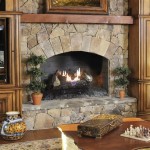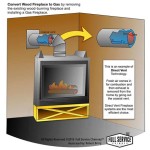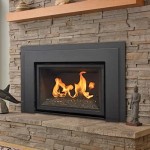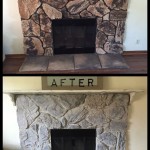Can You Replace A Gas Fireplace With A Wood Burning Stove?
The decision to replace a gas fireplace with a wood burning stove often stems from a desire for a more authentic, traditional heating experience. Wood burning stoves offer a distinct ambiance and can be a more cost-effective heating solution in some cases, particularly if firewood is readily available. However, undertaking such a conversion involves careful consideration of various factors, including building codes, safety regulations, installation requirements, and the overall suitability of the existing fireplace setup.
Before initiating any work, a thorough assessment of the existing gas fireplace and the surrounding structure is crucial. This evaluation should encompass the chimney system, the firebox dimensions, and the structural integrity of the fireplace surround. Understanding these elements is paramount to determining the feasibility and cost-effectiveness of the conversion. Ignorance of these factors can lead to significant complications, safety hazards, and potentially costly repairs down the line.
The presence of an existing gas fireplace does not automatically guarantee that its footprint and infrastructure are directly compatible with a wood burning stove. Gas fireplaces typically exhaust at lower temperatures than wood burning stoves. As such, the existing flue may not be adequately sized or constructed to handle the higher temperatures and creosote generated by burning wood. A properly functioning and appropriately sized chimney is essential for safe and efficient operation of a wood burning stove.
Furthermore, the aesthetic considerations are noteworthy. Replacing a sleek, modern gas fireplace with a rustic wood burning stove can drastically alter the room's overall design. Homeowners should carefully consider how the new stove will integrate with the existing décor and whether any modifications to the surrounding area will be necessary to achieve the desired look.
Chimney and Flue Requirements
The most significant aspect of converting a gas fireplace to a wood burning stove is the chimney. Gas fireplaces often vent through smaller diameter metal flues, designed for the relatively clean and cool exhaust produced by burning natural gas or propane. Wood burning stoves, on the other hand, generate significantly hotter exhaust and produce creosote, a highly flammable byproduct of incomplete combustion. For this reason, a wood burning stove typically requires a larger diameter, insulated chimney flue that is specifically rated for solid fuel burning. The existing gas fireplace flue is highly unlikely to be suitable for this purpose.
The chimney must be inspected by a qualified professional to ensure its structural integrity and suitability for wood burning. Cracks, deterioration, or inadequate insulation can create fire hazards and impede proper draft. Relining the chimney with a stainless steel liner of the appropriate size and rating is often necessary. This liner not only provides a safe and durable pathway for the exhaust but also helps to improve draft and reduce creosote buildup.
Selecting the correct size of the chimney liner is crucial. A liner that is too small can restrict airflow, leading to incomplete combustion and increased creosote production. A liner that is too large can result in excessive cooling of the exhaust gases, which can also contribute to creosote buildup. A qualified chimney professional will be able to assess the stove's specifications and recommend the appropriate liner size and installation methods.
In some cases, the existing chimney may be structurally unsound or located in a position that is not conducive to wood burning. In these situations, installing a completely new chimney may be the only viable option. While this is a more expensive undertaking, it ensures that the wood burning stove operates safely and efficiently.
Building Codes and Permits
Before commencing any conversion work, it is essential to obtain the necessary permits from the local building department. Building codes vary significantly from one jurisdiction to another, but they generally address issues such as chimney requirements, clearances to combustible materials, hearth protection, and ventilation. Installing a wood burning stove without the proper permits can result in fines, forced removal of the stove, and potential legal liabilities in the event of a fire or other incident.
The building department will typically require detailed plans of the proposed installation, including specifications for the stove, chimney, and hearth. These plans must demonstrate compliance with all applicable codes and regulations. An inspection will be conducted after the installation is complete to ensure that the work meets the required standards.
Compliance with building codes is not merely a matter of legal obligation; it is also a critical safety measure. These codes are designed to protect homeowners and their neighbors from the hazards associated with wood burning stoves, such as fire, carbon monoxide poisoning, and chimney fires. A thorough understanding of and adherence to these codes are essential for ensuring the safe and responsible operation of a wood burning stove.
Furthermore, insurance companies often require that wood burning stoves be installed in compliance with all applicable building codes. Failure to meet these requirements can invalidate the homeowner's insurance policy in the event of a fire or other incident related to the stove. It is advisable to consult with the insurance company prior to installing the stove to ensure that the installation will not affect coverage.
Installation Considerations and Safety Precautions
The installation process for a wood burning stove involves several critical steps that must be performed correctly to ensure safe and efficient operation. These steps include preparing the hearth, installing the stove, connecting the chimney, and testing the stove for proper draft and ventilation. It is strongly recommended that these tasks be performed by a qualified professional who has experience installing wood burning stoves and is familiar with local building codes.
The hearth, which is the non-combustible surface beneath and around the stove, must be of sufficient size and thickness to protect the floor from the heat generated by the stove. The required dimensions of the hearth are typically specified in the stove's installation manual and in the local building codes. The hearth may need to be extended beyond the front and sides of the stove to prevent embers from igniting nearby combustible materials.
Clearances to combustible materials, such as walls, furniture, and curtains, must also be carefully observed. These clearances are designed to prevent the stove from overheating nearby materials and causing a fire. The required clearances are typically specified in the stove's installation manual and may vary depending on the stove's design and heat output. Heat shields can be used to reduce the required clearances in some cases.
Once the stove is installed and connected to the chimney, it is essential to test it for proper draft and ventilation. This involves lighting a small fire in the stove and observing the smoke behavior. If the smoke is drawn up the chimney quickly and efficiently, the draft is likely adequate. If the smoke lingers or comes back into the room, the draft may be insufficient, and further investigation is needed. A qualified professional can use specialized instruments to measure the draft and identify any issues that may need to be addressed.
Carbon monoxide detectors should be installed in the home to provide early warning of any carbon monoxide leaks. Carbon monoxide is a colorless, odorless gas that can be produced by wood burning stoves if they are not properly ventilated. Carbon monoxide poisoning can be fatal, so it is essential to have working detectors in place.
Regular maintenance is crucial for ensuring the safe and efficient operation of a wood burning stove. This includes cleaning the chimney regularly to remove creosote buildup, inspecting the stove for any signs of damage or deterioration, and ensuring that the door seals are tight. A qualified chimney sweep can perform a thorough inspection and cleaning of the chimney to prevent chimney fires and other hazards.
In summary, replacing a gas fireplace with a wood burning stove is a feasible project, but it requires careful planning, adherence to building codes, and professional execution. A thorough assessment of the existing fireplace and chimney, proper installation of the stove and flue, and regular maintenance are essential for ensuring the safe and efficient operation of the new heating system.

Can You Convert A Gas Fireplace To Wood Burning Stove Direct Stoves Resources

Converting A Fireplace To Wood Burning Stove Chesneys

Replacing A Gas Fire With Wood Burner

Do You Want To Replace Your Gas Fire With A Woodburner

Converting A Fireplace To Wood Burning Stove Chesneys

Is It Time To Replace Your Old Gas Fire For A More Efficient Wood Burning Stove Alfred Poppins
Can I Convert My Wood Burning Fireplace To Gas Woodlanddirect Com

Want To Convert Gas Wood Fireplace Full Service Chimney

Do You Want To Replace Your Gas Fire With A Woodburner
Converting A Wood Burning Fireplace Into Gas Heat Glo
Related Posts








